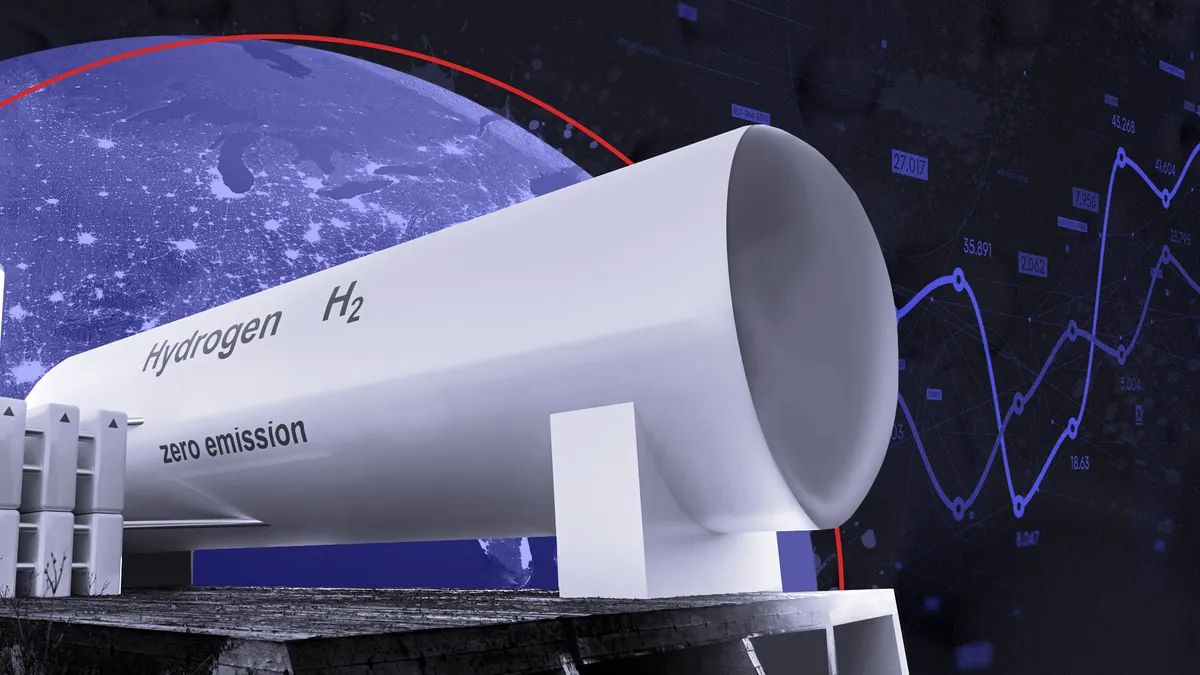Dive Brief:
- One Texas-based hydrogen project is poised to become a regional U.S. hydrogen hub just two years after the Energy Department-funded pilot started, the project engineer said Friday at the RE+ Texas conference in San Antonio.
- The Texas coast has 1,600 miles of hydrogen pipelines, many of which are retrofitted from natural gas. States other than Texas have only three to five miles of contiguous hydrogen-specific pipelines, Brian Weeks, senior director for hydrogen business development at the Gas Technology Institute, said at RE+ Texas.
- The H2@Scale project, which has attracted additional corporate partnerships, is converting renewable natural gas to hydrogen and investigating applications that include carbon capture, fuel cell technology, hydrogen blending with natural gas, and hydrogen liquefaction to store excess wind energy.
Dive Insight:
The bipartisan infrastructure law passed last fall gave the DOE until May 14 to issue a funding opportunity announcement for at least four regional hydrogen hubs, for a total of $8 billion in available funding. Weeks speculated, however, that the DOE might approve as many as 10 hubs, which would result in less federal funding per project.
The three-year Texas project, initially a collaboration between the University of Texas at Austin and Frontier Energy, a subsidiary of the Gas Technology Institute, has found more corporate sponsors since it launched.
H2@Scale in Texas and Beyond was one of 18 projects that received a total of roughly $64 million from the DOE's Hydrogen and Fuel Cell Technologies Office, which is within the Office of Energy Efficiency and Renewable Energy.
The Texas project now has attracted multiple corporate sponsors, including Southern California Gas and Shell. Other companies are approaching the team with interest in supporting the effort and becoming part of the hydrogen industry that could develop in the state, Weeks said in an interview at RE+. The project has expanded to evaluate several applications and serves as a "hydrogen proto-hub" in the state, he said.
The project "has the most technical potential in the U.S.," he said, given the advanced hydrogen pipeline network, and could be the basis for a regional hub stretching from Corpus Christi, Texas, into Louisiana.
Waste company WM, one of the corporate sponsors of the project, is providing landfill gas from a site it operates just outside of Dallas. The landfill gas is cleaned and used in the natural gas grid in a way that is "indistinguishable from other methane," Weeks said. That gas is used as feedstock for most of the hydrogen that's being produced at the H2@Scale site.
While this system does not yet have carbon capture technology, it has cut its overall carbon intensity by using a renewable natural gas source, Weeks said. "We actually are designing a carbon capture system for it," he said, which would convert methane to hydrogen and carbon dioxide through two separate reactor processes.
Piloting carbon dioxide capture is difficult because of the economics, said Weeks, who is the project engineer: small-scale projects will be too expensive. "I'd rather have a thousand tons of CO2 a day," he said. "It'd be easier to deal with than it would be to deal with 100 pounds of CO2 a day."
The project has since expanded beyond the Port of Houston in its research on a variety of hydrogen applications. In one instance, the partnership is evaluating the hydrogen production potential, as well as the potential for carbon dioxide sequestration, in the Permian Basin.
"There's a lot of interest in blending hydrogen in the gas pipeline network. We're actually looking at real segments of pipelines," Weeks said. The developers are studying different blends of hydrogen in 100-mile sections of pipeline and the potential customers in those regions.
The H2@Scale in Texas and Beyond project is also working on hydrogen liquefaction, which is an option for capitalizing on excess wind energy.
"When [wind] capacity is not able to be dispatched because of congestion on the transmission grid, what if we convert it to hydrogen and liquefy it into market, so [it's] another way to monetize again that renewable capacity" that would not get used otherwise, Weeks said.
The Texas initiative is focused on studying the most cost-effective ways to transport energy. According to the DOE, replacing one natural gas pipeline would require constructing eight of the largest-capacity transmission lines.
Critics of hydrogen expansion have pointed to the potential for leaks, because hydrogen is such a light molecule, and the high cost of retrofitting gas pipelines compared with investments in renewables.
"I'm stepping into the controversial areas because pipelines are pretty much hated these days, but... When we talk about electrifying everything, we have to keep in mind the incredible amount of infrastructure transmission that is involved," Weeks said.













